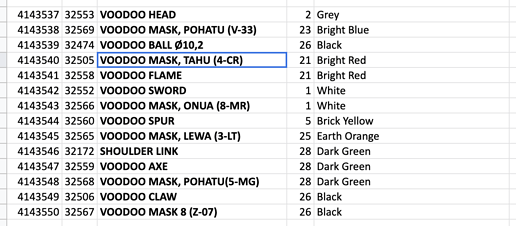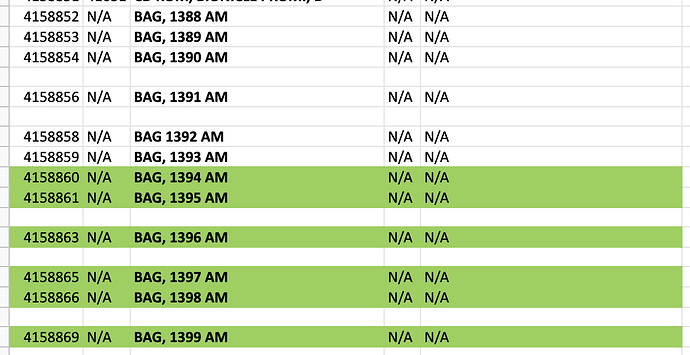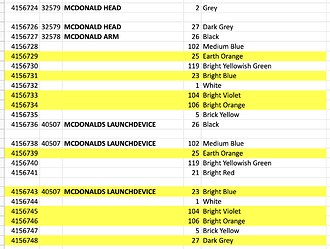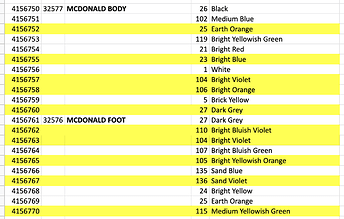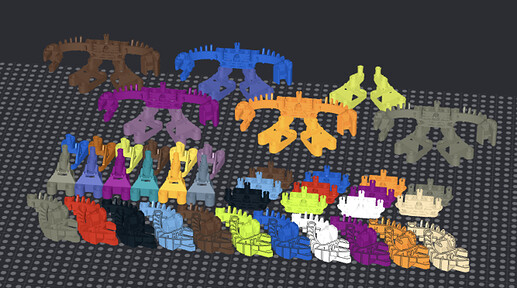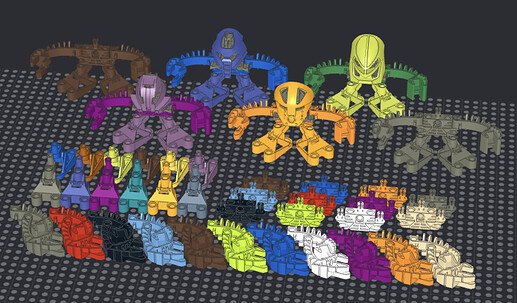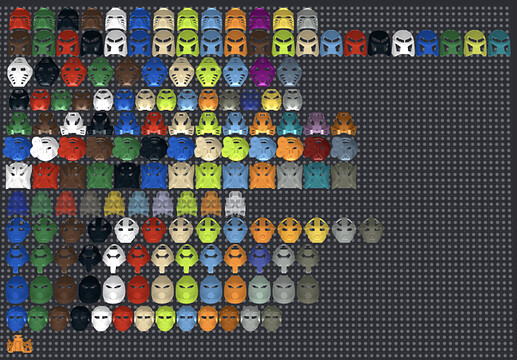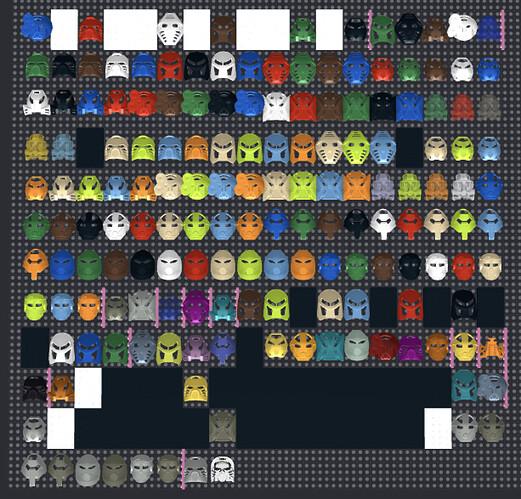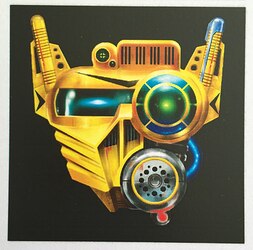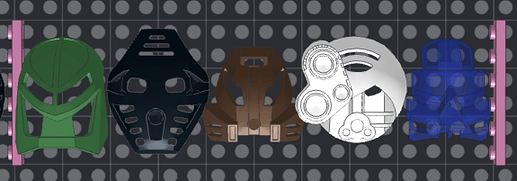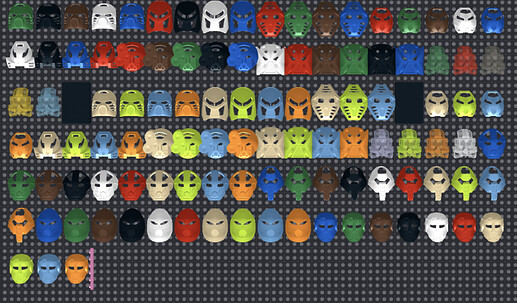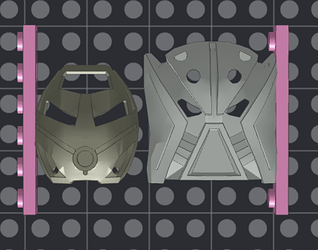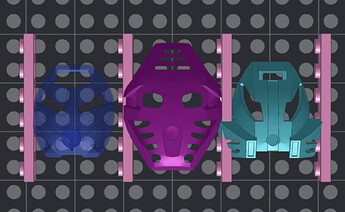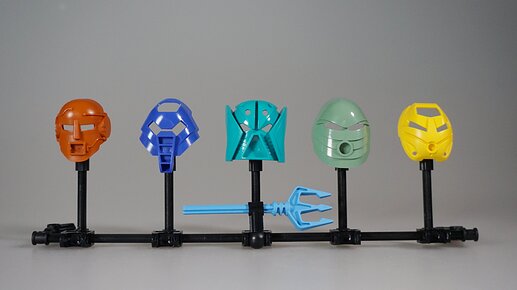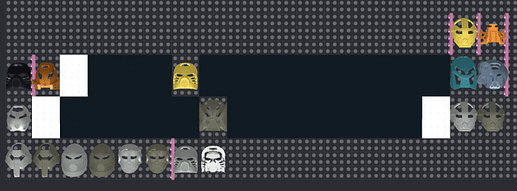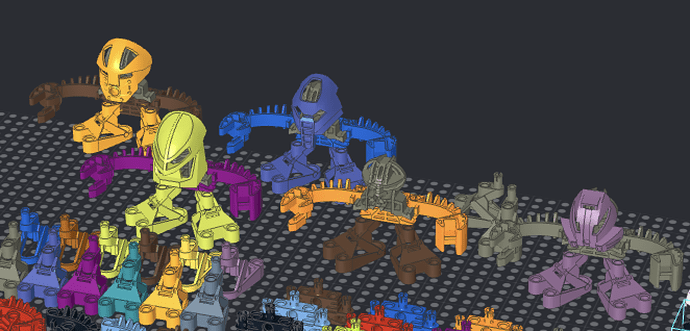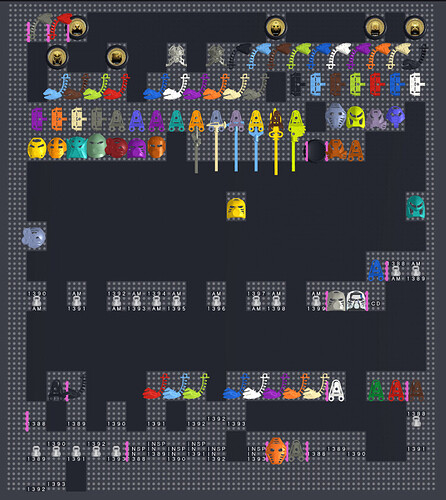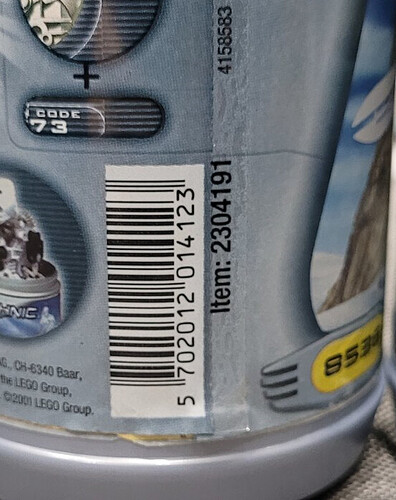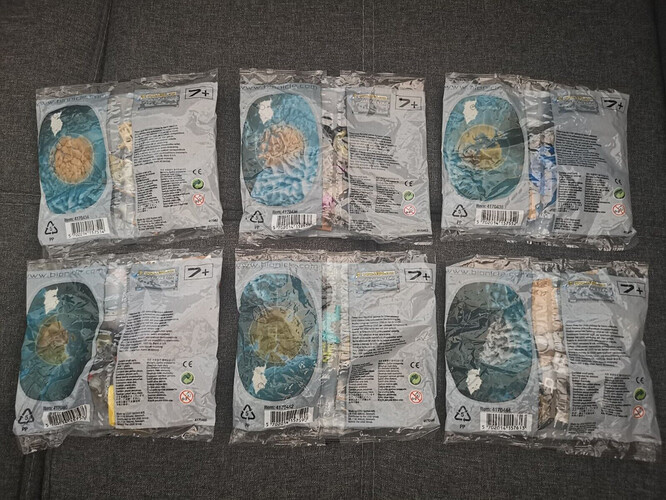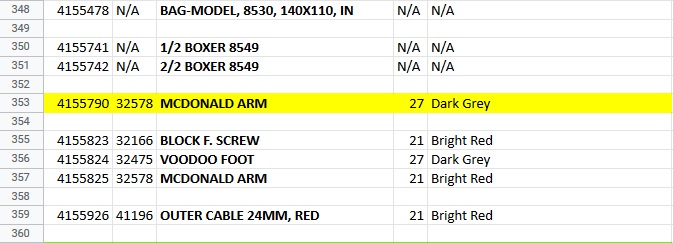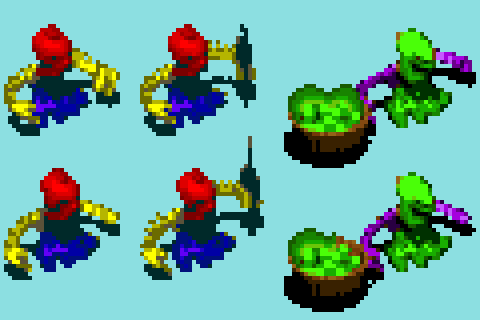Recently, my friend (and excellent community member) Wolk shared with me a finding he had observed in bionicle_elements.xlsx, a spreadsheet created by fellow community member Aanchir a number of years ago. On this sheet, Aanchir went through the LEGO customer service site, looking up element IDs and recording what they were associated with. She essentially was datamining, and she made some crazy cool discoveries, but the sheet is a little bit inscrutable due to its purely-text nature.
Let’s start with a preface before I get into the wild rabbit hole of mine and Wolk’s discoveries: element IDs. For those unfamiliar, LEGO catalogs its parts internally through a number of numerical IDs - each color is assigned an ID, as well as each mold, and each combination of a color (sometimes more than one color) and a mold is assigned an element ID. Each element ID, when looked up, will tell you the mold number, the color ID, and a text name assigned to the ID that helps describe what it is. For example, our good friend the red Kanohi Hau has the mold ID of 32505, which is common to most variants of the Hau; the color ID 21 for Bright Red; the element ID 4143540; and the assigned name “VOODOO MASK, TAHU (4-CR)”.
The cool thing about element IDs is that they aren’t only assigned to parts - just about everything LEGO produces is assigned an element ID, from instruction books to set packaging. If it’s in a set, it has an element ID, and then some. Something else important to note is that element IDs are only assigned to elements that were produced in large quantities, i.e. not prototype pieces.
This brings me to Wolk’s observation: six element IDs assigned to polybags for unreleased sets, whose set numbers place them directly after the McToran. In the below screenshot, these are highlighted in green.
As a refresher, the McToran are assigned the set numbers 1388-1393, with 1388 being Huki and 1393 being Matoro. 1394-1399 were never released under any line. So, at first glance, these appear to be indications that either 12 McToran were intended to be released, or a second wave of them were planned at some point. My first instinct was to try to see if I could reconstruct how these McToran may have looked. Interestingly enough, there are unreleased colorways of the McToran pieces found in this document as well.
Popping these unreleased elements into Studio, this is what I got:
I placed each colorway and then combined the unreleased ones in ways I thought most likely in order to build these Matoran. There are a few snags; for one, the grey and brown Matoran are monochrome; for another, there’s no body for the medium lime one. The strange colors visible here are sand purple, medium orange (like on the beak of Gukko), medium lime, and violet (the color of Nick Bluetooth’s jet wing arms).
This is a good start, but then, I noticed that there were masks in colors matching these unreleased feet as well. I placed the ones I felt appropriate on these Matoran:
Isn’t that kind of crazy? A sand purple Kakama? Medium orange Komau? Violet Huna? Medium lime Miru? Let this one sink in - these are all real parts that we have evidence for the existence of. We just don’t know where they are. (You may notice in the screenshot I have added a green body to the medium lime Matoran - this is based on the existence of a green body and arms that were prototypes, and thus not included on the sheet.)
So, the grey one and brown one still don’t have masks. Since I was having trouble determining what should go where, I opted to just visually record all of the masks molded in 2001 that could be found on the sheet, sorted by mold number then element ID. There are some crazy things happening in this lineup, but they will become more apparent in a second:
I am going to skip over all of the questions this presented me for now, because they will be asked again in a moment, and given the inkling of an answer too. As it is, this layout is a little too messy to perfectly analyze. On the suggestion of SubParFauxPas, I sorted all of the masks by element ID. The result of this kind of blew my mind in several ways:
In this image, white cells represent element IDs that are used by parts that are not masks. Black cells represent element IDs that are either unused or allocated in such a way that Aanchir was not able to record them. Pink dividers represent gaps in the element ID space that may or may not contain parts, but were removed for brevity’s sake.
So, what’s so crazy about this pic? Let me count the ways…
- The first six masks
Uhh, what?? The first six masks produced… One of each of the six primary colors, but not in the default shape for these elements? A blue Akaku, a red Hau, a white Pakari, a brown Miru, a green Kakama, and a black… Ruru? This was genuinely so exciting for me to see, is this evidence of a previous iteration of the Toa Mata?
a. “Pohatu’s blue Akaku”
This sounds like an oxymoron at first but hear me out. Recall the very first screenshot included in this post (I know that was awhile ago at this point):
The first mask in this screenshot is element ID 4143538, mold number 32569, “VOODOO MASK, POHATU (V-33)”, color ID 23 (Bright Blue). But wait, what’s going on here? 32569 is the mold ID for the Akaku. And why is Pohatu’s mask blue? Even stranger, V-33 is the correct code printed on the inside of the Akaku, the Kakama has 5-MG printed inside it. So the very earliest-produced BIONICLE mask was a blue Kanohi Akaku, whose element ID was intentionally defined with a reference to Pohatu. See what I mean about “Pohatu’s blue Akaku”? Sure, this could be a mistake, but take into account this observation by Discord user r543: Scuba Throwbot / Sub Slizer has a scope on its face print, which would bring parity with a hypothetical Akaku-wearing Toa of Water.
- The actual masks of the Toa Mata are finalized
This one isn’t so crazy, but, as a fun fact, Gali’s mask was the first BIONICLE mask to be designed in a 3D-modelling program known as a CAD (as opposed to being sculpted in clay and miniaturized). These IDs are allocated around 200 slots after the original six masks. - Secondary shuffle
After the main six masks are finalized, the designers get to work on the rest of the masks, as well as defining the secondary colors for each element. We can see not only that four secondaries were determined: orange for Fire, medium blue for Water, lime for Air, and tan for Stone; we can also see that, at first, the Noble masks were created in all six Toa colors (this means we can pretty definitively state that the so-called “misprints” of the Noble masks in Toa colors are not “misprints” as much as “accidentally released”).
Something else to observe in this screenshot: the various Kaukau. Recall that, in the “official release,” Pohatu wears a trans-neon orange Kaukau, while Kopaka wears a clear one. Now, look at the first five Kaukau: transparent green, transparent red, transparent brown/black, transparent neon yellow, and transparent medium blue. Now, these last two colorways are also somewhat widely regarded as “misprints” in the community, but this presents evidence not only that they were created on purpose, but created in order to be Pohatu’s and Kopaka’s Akaku, respectively. Evidently, plans changed, as LEGO’s transparent palette was more restrictive than the designers bargained for. Four more Kaukau show up in the list: transparent purple, transparent neon green, and the familiar transparent neon orange and transparent clear. This, along with another observation we will note later, may explain not only why all 12 masks were not released in 12 colors, but also why Maku was the only McToran not to wear her respective Toa’s mask.
Two more oddities to note in this spread: there are two “obfuscated” IDs. I originally referred to these as “null” IDs, but Wolk, who is more knowledgeable than I on this topic, advised me not to use that word, as it’s unlikely LEGO would leave IDs completely blank. Instead, these were unable to be datamined by Aanchir for some reason or another. The two “obfuscated” IDs are something between the primary-colored Kaukau and the secondary-colored Hau, and another where an orange Pakari would logically fit. I don’t know what would appear in the first slot, but the orange Pakari did appear the next year in 2002, which may be part of why the ID was “blanked.” - Oops, we forgot about Earth and Ice
So, it seems, for some reason, the designers had a hard time choosing what the secondaries would be for Earth and Ice. They did decide, but far after the main block of mask IDs were allocated, and also after the initial plan to create all 12 masks in all 12 colors was dropped. - Rahi masks
The Rahi sets are being designed now. Nothing especially weird going on in this spread. - Lewa’s masks are remade
I genuinely cannot think of a reason for why this occurred. Midway through the design of the Rahi, all but one of Lewa’s masks are assigned new element IDs (the orange Miru is left out). This leaves all nine of these Miru with two element IDs, for some reason, which is unique among all other Kanohi (except “Pohatu’s blue Akaku”). There are a number of “obfuscated” or “null” IDs in this range, and I have no guess as to what they could represent. - The test range
This is one of the most important parts of this data to me. Still before the Rahi sets are done being designed, 12 element IDs are allocated for molds of one of each of the masks in unique or rare colors. We get a Pakari in sand blue, a Miru in medium lime, a Kakama in sand purple, a Huna in violet, a Ruru in yellow, a Komau in medium orange, a Matatu in turquoise, a Rau in sand green, an Akaku in dark red, a Hau in purple, and a Mahiki in dark orange. The 12th mask was likely a Kaukau, as it’s the only one not represented in this set, but the slot where it would be is obfuscated. Wolk and I theorized that it would have been glow-in-the-dark, like Onua’s eyes were originally intended to be.
Not only is this evidence that these masks exist, some of them have been found. Recently, Twitter user OwlKid_ came into possession of five of these masks:
So we know, with room for some reasonable doubt, that the rest of these masks are, or have been, out there.
Now, why were these masks made? Notably, some of them line up with unreleased McToran part colors (the original purpose of this investigation). Wolk suggested that it was more likely that these were simply created as tests for color schemes, which I agree on. Each of the McToran (except Maku) featured a tertiary color for their element’s color scheme, all of which are represented in this set. Perhaps, in an attempt to avoid the scramble of the Earth and Ice secondaries, they devoted specific effort to developing tertiary colors for each element. Note that Water is the only one to lack a tertiary until 2003, when dark blue is introduced - this is likely related to the McToran Kaukau situation. My hypothesis, to reiterate, is just that LEGO’s transparent color palette (i.e. Kaukau color palette) was too restrictive to allow this to happen. - Finishing up
At this point, the element ID allocation for masks was almost complete. We can see the Manas design finalized when the yellow Komau is created, then the Vahi, then the infected Hau. Some notes: the Vahi’s name is “MASK FOR MEDIA”, indicating its original purpose as an inclusion in the cancelled PC game; the infected Hau has a different mold ID to the Hau and is called “LAQUERED MASK F. 8538”. Its mold ID likely differs because the Hau would first have been molded in black and then painted, meaning the infected Hau’s “mold” requires a pre-made part included, in effect changing its mold. We can see this happen later with the Power Pack chrome Hau.
Afterwards, the McToran are designed. We can see their masks created using colors decided upon in the test range. After that, the Turaga masks are molded in the shades of grey decided upon as the secondaries for Earth and Ice. The last two masks made for 2001 were a light grey Hau and the chrome Hau from the Power Pack. Now, as you may know, if you scratch the chrome lacquering off of the Power Pack Hau, you get a light grey one, a color that the Hau is otherwise unavailable in. This, combined with the fact that “METAL. MASK, UNIV. POWER PACK” has a mold ID of 42031 (different from the original Hau once again), indicates that the light grey Hau were intentionally molded first to be chromed.
…phew, that’s it. Just a few more notes and I can let you go. First of all, this data reflects only masks, and only the ones molded in 2001. Aanchir’s data is also not entirely complete, as there are entries missing, such as all of the golden Kanohi. Masks such as the copper Huna and Komau and the trans-neon green Miru were molded in 2002 and as such are not part of this data. Finally, please feel free to explore her sheet yourself! I find that every time I look at it I come across something new and interesting that gets the wheels turning in my mind. I hope you guys found this an interesting read, and let me know what you think.
TL;DR: evidence of an unreleased wave of 6 more McToran; tons of unreleased masks should be out there somewhere; evidence for a different design for the Toa Mata(?); the yellow and medium blue Kaukau are not misprints, and neither are the Noble masks in the Toa’s colors; and, who would’ve guessed it?, planning for the earliest iterations of BIONICLE did not go smoothly. Thanks for your time!
